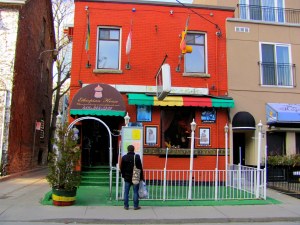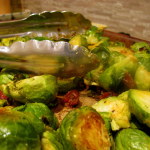 I was first brought to this little pocket of African culture in the city of Toronto by my good friend, K.
I was first brought to this little pocket of African culture in the city of Toronto by my good friend, K.
I had the good fortune to meet my friend K while studying Life Sciences at Queen’s University. K is from a dynamic family background consisting of Armenian and Colombian roots. She also had a childhood much like the one my mom had; her dad is an RCMP officer and she spent her school-age years moving to and living in different parts of North and South America. She is also fluent in four languages: English, Spanish, Armenian and French. Her father is an interesting man who traveled the world during his youth and adulthood and was born and raised in Ethiopia. He introduced his daughter, my friend K, to delicious Ethiopian cuisine.
While visiting me and her brother in Toronto one summer, K invited me to the place she christened “the best Ethiopian food in all of Toronto”. Having tasted most of the Ethiopian food in Canada, I figured she knew what she was talking about. It was the first time I’d even heard of Ethiopian cuisine and, needless to say, the food at Ethiopian House was delicious.
The location is Irwin St. (just off of Yonge St.) in Toronto, Canada. The charming, colourful decor puts you right in the center of the constant celebration of cultural and ethnic diversity that is Toronto. In fact, it’s places like these – where you can step off of the very North American strip club and tattoo-parloured Yonge Street and enter a piece of Africa – that make me miss Toronto the most when I travel. The walls are decorated with Ethiopian paintings, the scent of roasting coffee beans paints the air and the tables are served by a bonafide Rastafarian – the roots of the Rastafarian religion are in Ethiopia. The religion claims that Ethiopia’s king Haile Selassie, or Ras. Tafari, was the second coming of Christ.
An Ethiopian meal consists of a large plate full of spicy, colourful stews made of legumes, vegetables and, sometimes, meats. The plate, resembling an artist’s paint palate, is decorated with different pools of these flavourful stews. The meal is served with injera, which are crepes made of fermented teff, and the food is eaten with bare hands (hello, fun!), by breaking off pieces of injera and using it to scoop up the saucy dishes.
Ethiopian food is a perfect marriage of all of the 6 tastes of Ayurveda and you leave the table with the pleasantly warm feeling of satisfaction. The food is easily digested and one leaves feeling nourished and happy, not overstuffed, bloated or lethargic. This is an amazing post-meal experience that is not common for me, especially when eating out. Depending on your food preferences, Ethiopian House offers gluten and diary free meals (teff is naturally gluten free) and, if you order the vegetarian option, it’s also completely vegan. Paleo people can order a meat dish and just use their napkin to eat the curries instead of injera (I kid, I kid)!
I recommend the Ethiopian House dining experience to almost everyone I meet and I bring all of my friends who visit Toronto there. I believe it represents a lot of what Toronto stands for; the acceptance of cultural diversity and the willingness to experience the colours and flavours of other cultures from within the context and comfort of our cosmopolitan city. I am proud to show visitors this aspect of Toronto and I find that experiences like these enrich my view of the world my ability to embrace other cultures.
When Joe was visiting from Colombia I brought him to Ethiopian House (as per his request, as he often heard me raving about the place) for lunch. The lunch special is $8.00 for a large vegetarian dish, including unlimited injera. I ordered this, and he ordered the meat lunch special ($8.50) and left feeling happy, full and inspired.
As the Colombians say: Bueno, Bonito y Barato (good, nice and cheap)!










Awesome! I’ve lived in Toronto for 15 years and haven’t eaten at an Ethiopian restaurant in Toronto yet, though I did try Ethiopian cuisine in Waterloo (where I went to university). Sounds like a place to visit when I go home!
You should definitely check it out! Thanks for the comment!
Yup I tried this place as per your recommendation and was VERY happy indeed! Now I want to go back after seeing these pics!! LOVE eating with my hands 🙂
I know! I didn’t want to go last time because I wasn’t that hungry… but I managed to eat everything and you don’t end up feeling stuffed and tired as I always do after eating out. I felt great! But I didn’t need dinner…
Talia, I love this place! I lived fairly close to it during my undergrad. They have awesome coffee + popcorn dessert if you order it at the beginning of the meal. Just wondering though, I thought injera was usually made from fermented teff flour?
Hey, Jola! You’re right, the injera is made of teff flour. Teff (according to wikipedia) is full of protein and iron. But as far as I can tell, millet and teff are fairly similar species. There are various kinds of millet and finger millet is the kind that grows in Ethiopia and is used to make similar foods to injera. Ahhh the exciting world of grains! Makes me think that I would do very very poorly on a grain-free (paleo) diet! And yes Ethiopia is where coffee’s roots are (correct me if I’m wrong) and you can literally stand a spoon up straight in it. It’s like jet fuel… delicious! We should all plan a CCNM dinner there one of these days.
Gah! I have to go here… hopefully soon! Thanks for the review.
It’s the best! Thanks for commenting!